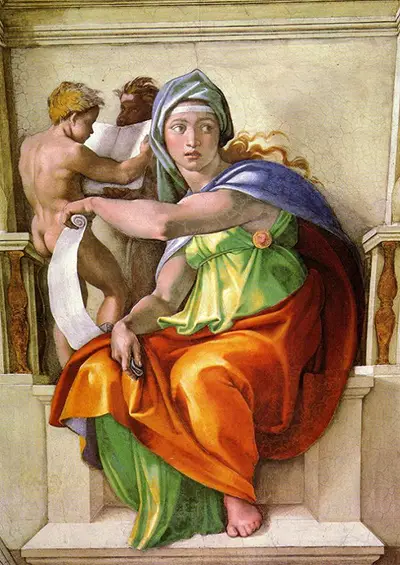This particular case, the surface being a ceiling, presented several practical problems; Michelangelo even had to design a scaffold before embarking on the mammoth project. In spite of the difficulties, Michelangelo has given us an enchanting, and very beautiful, Delphic Sybil. Her youthful face is winsome and exceeding fair.
All the curves and drapes in her clothing are solid yet light, strong yet delicate; the colours with the light bouncing off them are warm and vibrant; the sweep of her well-formed arm and the turn of her head are exquisitely rendered. Her candid eyes behold the future.
It was said in the ancient world that the Delphic Sybil's prophetic powers were formidable. Also known as Herophile Sibyl, scholars believe she was one of the first farseeing Sibyls.
Her story goes back a long way. She was said to have started making prophecies, chanting proclamations about future events, from the so-called "Sibyl Rock", a natural rock rostrum located near the Temple of Apollo at Delphi. She was admired and revered, her revelations were on track and her prophetic gift ensured her fame throughout the ancient world.
Pausanias, a second century Greek travel-writer who reported stories he heard on his travels, informs us she lived before the Trojan war, and that she had even predicted that "Helen of Sparta would bring ruin to Asia and cause the Greeks to attack Troy" (Pausanias, "Description of Greece", Book 10.12.2)
The Sistine Chapel ceiling, the quintessence of High Renaissance Art, was painted between 1508 and 1512. The "Delphic Sibyl", painted in 1509, can be seen amongst the array of out-facing scenes around the ceiling, along with a host of saints, prophets and biblical figures, all strategically positioned within the holy landscapes and the celestial architecture of the heavens.
The "Delphic Sibyl" is part of the series of twelve prophetic figures: seven prophets and five sibyls who had in some way predicted the coming of Jesus. She is located next to the corner pendentive of "Judith and Holofernes" with her putto attendant at her back reading from a large book.
The youthful loveliness of the Delphic Sibyl immediately draws the attention. She is seated on a stone chair, one foot forward, left arm up, holding a scroll. Her arms are in movement, she is in movement, she has just turned her head and her beautiful face looks rather worried. Has she seen some unpleasant future event?
Michelangelo gave the world this exquisite "Delphic Sibyl" in 1509. Michelangelo Buonarroti (1475-1564), born and raised in Tuscany, revealed his extraordinary artistic talent at an early age. He studied art in Florence and was soon called to Rome to paint and to sculpt for Pope Julius II, who had ambitious plans for the Papal palace and wanted the greatest artists of the day to carry them out.
In Michelangelo, Julius commissioned one of the greatest artists of all time to paint one of the greatest artworks of all time: The Sistine Chapel ceiling.
The "Warrior Pope" Julius II, so called because of his active militarist policies (he had even led troops into battle), was also appreciative of the arts.
In 1506, he conceived a plan to have the entire ceiling of the Sistine Chapel painted with scenes from the Bible; work started in 1508. Michelangelo was primarily a sculptor, he much preferred working with stone or marble, and he accepted to undertake this grandiose painting project with a certain reluctance.
He and Julius II argued frequently about details and methods of carrying out the work, their disagreements becoming almost as well-known as the project itself. The work took four years to complete.


